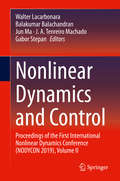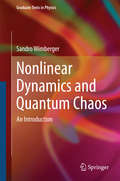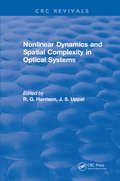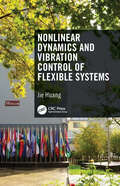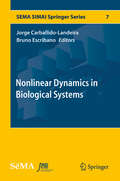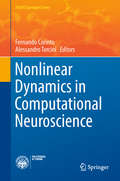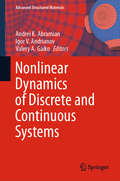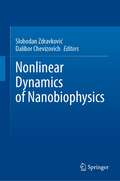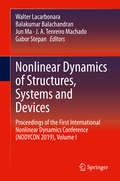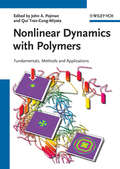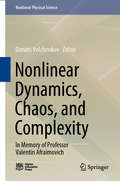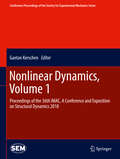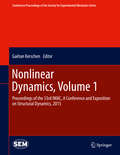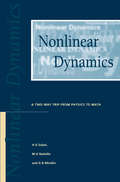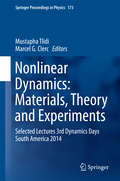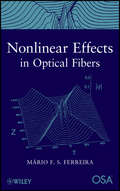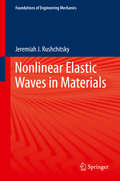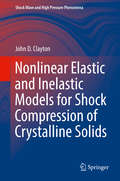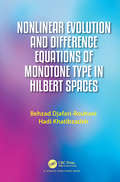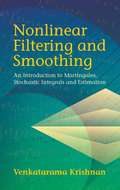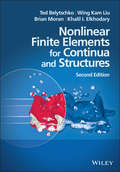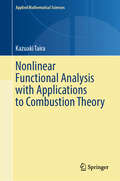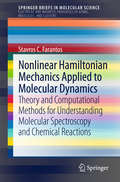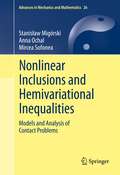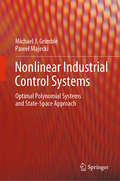- Table View
- List View
Nonlinear Dynamics and Control: Proceedings of the First International Nonlinear Dynamics Conference (NODYCON 2019), Volume II
by Jun Ma Walter Lacarbonara J. A. Tenreiro Machado Balakumar Balachandran Gabor StepanThis second of three volumes from the inaugural NODYCON, held at the University of Rome, in February of 2019, presents papers devoted to Nonlinear Dynamics and Control. The collection features both well-established streams of research as well as novel areas and emerging fields of investigation. Topics in Volume II include influence of nonlinearities on vibration control systems; passive, semi-active, active control of structures and systems; synchronization; robotics and human-machine interaction; network dynamics control (multi-agent systems, leader-follower dynamics, swarm dynamics, biological networks dynamics); and fractional-order control.
Nonlinear Dynamics and Quantum Chaos
by Sandro WimbergerThe field of nonlinear dynamics and chaos has grown very much over the last few decades and is becoming more and more relevant in different disciplines. This book presents a clear and concise introduction to the field of nonlinear dynamics and chaos, suitable for graduate students in mathematics, physics, chemistry, engineering, and in natural sciences in general. It provides a thorough and modern introduction to the concepts of Hamiltonian dynamical systems' theory combining in a comprehensive way classical and quantum mechanical description. It covers a wide range of topics usually not found in similar books. Motivations of the respective subjects and a clear presentation eases the understanding. The book is based on lectures on classical and quantum chaos held by the author at Heidelberg University. It contains exercises and worked examples, which makes it ideal for an introductory course for students as well as for researchers starting to work in the field.
Nonlinear Dynamics and Spatial Complexity in Optical Systems (Scottish Graduate Ser. #41)
by R. G. HarrisonA collection of prestigious postgraduate lectures, Nonlinear Dynamics and Spatial Complexity in Optical Systems reviews developments in the theory and practice of nonlinear dynamics and structural complexity, and explores modern-day applications in nonlinear optics. The book addresses systems including both singlemode and multimode lasers, bistable and multistable devices, optical fibers, counter-propagating beam interactions, nonlinear mixing, and related optical phenomena.
Nonlinear Dynamics and Vibration Control of Flexible Systems
by JIE HUANGThis book is an essential guide to nonlinear dynamics and vibration control, detailing both the theory and the practical industrial applications within all aspects of engineering. Demonstrating how to improve efficiency through reducing unwanted vibration, it will aid both students and engineers in practically and safely improving flexible structures through control methods. Increasing demand for light-weight robotic systems and space applications has actuated the design and construction of more flexible structures. These flexible structures, involving numerous dynamic systems, experience unwanted vibrations, impacting accuracy, operating speed, safety and, importantly, efficiency. This book aids engineers in assuaging this issue through vibration control methods, including nonlinear dynamics. It covers topics such as dynamic modeling of nonlinear system, nonlinear oscillators, and modal analyses of multiple-mode system. It also looks at vibration control methods including linear control, nonlinear control, intelligent control, and command smoothers. These control methods are effective and reliable methods to counteract unwanted vibrations. The book is practically minded, using industrial applications throughout, such as bridge cranes, tower cranes, aerial cranes and liquid sloshing. It also discusses cable-suspension structures, light-weight links, and fluid motions which exhibit flexible-structure dynamics. The book will be of interest to students and engineers alike, in the field of mechatronics, mechanical systems and signal processing, nonlinear dynamics, vibration, and control engineering.
Nonlinear Dynamics in Biological Systems
by Jorge Carballido-Landeira Bruno EscribanoThis book presents recent researchresults relating to applications of nonlinear dynamics, focusing specificallyon four topics of wide interest: heart dynamics, DNA/RNA, cell mobility, andproteins. The book derives from the First BCAM Workshop on Nonlinear Dynamicsin Biological Systems, held in June 2014 at the Basque Center of AppliedMathematics (BCAM). At this international meeting, researchers from differentbut complementary backgrounds, including molecular dynamics, physical chemistry,bio-informatics and biophysics, presented their most recent results anddiscussed the future direction of their studies using theoretical, mathematicalmodeling and experimental approaches. Such was the level of interest stimulatedthat the decision was taken to produce this publication, with the organizers ofthe event acting as editors. All of the contributing authors are researchers workingon diverse biological problems that can be approached using nonlinear dynamics. The book will appeal especially to applied mathematicians, biophysicists, andcomputational biologists.
Nonlinear Dynamics in Computational Neuroscience (PoliTO Springer Series)
by Fernando Corinto Alessandro TorciniThis book provides an essential overview of computational neuroscience. It addresses a broad range of aspects, from physiology to nonlinear dynamical approaches to understanding neural computation, and from the simulation of brain circuits to the development of engineering devices and platforms for neuromorphic computation. Written by leading experts in such diverse fields as neuroscience, physics, psychology, neural engineering, cognitive science and applied mathematics, the book reflects the remarkable advances that have been made in the field of computational neuroscience, an emerging discipline devoted to the study of brain functions in terms of the information-processing properties of the structures forming the nervous system. The contents build on the workshop “Nonlinear Dynamics in Computational Neuroscience: from Physics and Biology to ICT,” which was held in Torino, Italy in September 2015.
Nonlinear Dynamics of Discrete and Continuous Systems (Advanced Structured Materials #139)
by Igor V. Andrianov Andrei K. Abramian Valery A. GaikoThis book commemorates the 60th birthday of Dr. Wim van Horssen, a specialist in nonlinear dynamic and wave processes in solids, fluids and structures. In honor of Dr. Horssen’s contributions to the field, it presents papers discussing topics such as the current problems of the theory of nonlinear dynamic processes in continua and structures; applications, including discrete and continuous dynamic models of structures and media; and problems of asymptotic approaches.
Nonlinear Dynamics of Nanobiophysics
by Slobodan Zdravković Dalibor ChevizovichThis book highlights important aspects of nonlinear dynamics of biophysical nanosystems, such as DNA, alpha helix, and microtubules. It presents the differences between the linear and nonlinear models in these molecules and includes interesting chapters on Soliton dynamics of the DNA molecule. This book is meant not only for researchers but also for both graduate and undergraduate students. Chapters include derivations, detailed explanations, and exercises for students. Therefore, the book is convenient to be used as a textbook in suitable courses.
Nonlinear Dynamics of Structures, Systems and Devices: Proceedings of the First International Nonlinear Dynamics Conference (NODYCON 2019), Volume I
by Jun Ma Walter Lacarbonara J. A. Tenreiro Machado Balakumar Balachandran Gabor StepanThis first of three volumes from the inaugural NODYCON, held at the University of Rome, in February of 2019, presents papers devoted to Nonlinear Dynamics of Structures, Systems and Devices. The collection features both well-established streams of research as well as novel areas and emerging fields of investigation. Topics in Volume I include multi-scale dynamics: coexistence of multiple time/space scales, large system dynamics; dynamics of structures/industrial machines/equipment/facilities (e.g., cable transportation systems, suspension bridges, cranes, vehicles); nonlinear interactions: parametric vibrations with single/multi-frequency excitations, multiple external and autoparametric resonances in multi-dof systems; nonlinear system identification: parametric/nonparametric identification, data-driven identification; experimental dynamics: benchmark experiments, experimental methods, instrumentation techniques, measurements in harsh environments, experimental validation of nonlinear models; wave propagation, solitons, kinks, breathers; solution methods for pdes: Lie groups, Hirota’s method, perturbation methods, etc; nonlinear waves in media (granular materials, porous materials, materials with memory); composite structures: multi-layer, functionally graded, thermal loading; fluid/structure interaction; nonsmooth and retarded dynamics: systems with impacts, free play, stick-slip, friction hysteresis; nonlinear systems with time and/or space delays; stability of delay differential equations, differential-algebraic equations; space/time reduced-order modeling: enhanced discretization methods, center manifold reduction, nonlinear normal modes, normal forms; fractional-order systems; computational techniques: efficient algorithms, use of symbolic manipulators, integration of symbolic manipulation and numerical methods, use of parallel processors; and multibody dynamics: rigid and flexible multibody system dynamics, impact and contact mechanics, tire modeling, railroad vehicle dynamics, computational multibody dynamics.
Nonlinear Dynamics with Polymers: Fundamentals, Methods and Applications
by John A. PojmanClosing a gap in the literature, this is the first comprehensive handbook on this modern and important polymer topic. Edited by highly experienced and top scientists in the field, this ready reference covers all aspects, including material science, biopolymers, gels, phase separating systems, frontal polymerization and much more. The introductory chapter offers the perfect starting point for the non-expert.
Nonlinear Dynamics, Chaos, and Complexity: In Memory of Professor Valentin Afraimovich (Nonlinear Physical Science)
by Dimitri VolchenkovThis book demonstrates how mathematical methods and techniques can be used in synergy and create a new way of looking at complex systems. It becomes clear nowadays that the standard (graph-based) network approach, in which observable events and transportation hubs are represented by nodes and relations between them are represented by edges, fails to describe the important properties of complex systems, capture the dependence between their scales, and anticipate their future developments. Therefore, authors in this book discuss the new generalized theories capable to describe a complex nexus of dependences in multi-level complex systems and to effectively engineer their important functions. The collection of works devoted to the memory of Professor Valentin Afraimovich introduces new concepts, methods, and applications in nonlinear dynamical systems covering physical problems and mathematical modelling relevant to molecular biology, genetics, neurosciences, artificial intelligence as well as classic problems in physics, machine learning, brain and urban dynamics. The book can be read by mathematicians, physicists, complex systems scientists, IT specialists, civil engineers, data scientists, urban planners, and even musicians (with some mathematical background).
Nonlinear Dynamics, Volume 1: Proceedings of the 36th IMAC, A Conference and Exposition on Structural Dynamics 2018 (Conference Proceedings of the Society for Experimental Mechanics Series)
by Gaetan KerschenNonlinear Dynamics, Volume 1: Proceedings of the 36th IMAC, A Conference and Exposition on Structural Dynamics, 2018, the first volume of nine from the Conference brings together contributions to this important area of research and engineering. The collection presents early findings and case studies on fundamental and applied aspects of Nonlinear Dynamics, including papers on: Nonlinear System IdentificationNonlinear Modeling & SimulationNonlinear Reduced-order ModelingNonlinearity in PracticeNonlinearity in Aerospace SystemsNonlinearity in Multi-Physics SystemsNonlinear Modes and Modal InteractionsExperimental Nonlinear Dynamics
Nonlinear Dynamics, Volume 2
by Gaetan KerschenThis second volume of eight from the IMAC - XXXII Conference, brings together contributions to this important area of research and engineering. The collection presents early findings and case studies on fundamental and applied aspects of Structural Dynamics, including papers on: Linear Systems Substructure Modelling Adaptive Structures Experimental Techniques Analytical Methods Damage Detection Damping of Materials & Members Modal Parameter Identification Modal Testing Methods System Identification Active Control Modal Parameter Estimation Processing Modal Data
Nonlinear Dynamics: A Two-Way Trip from Physics to Math
by H.G SolariNonlinear Dynamics: A Two-Way Trip from Physics to Math provides readers with the mathematical tools of nonlinear dynamics to tackle problems in all areas of physics. The selection of topics emphasizes bifurcation theory and topological analysis of dynamical systems. The book includes real-life problems and experiments as well as exercises and work
Nonlinear Dynamics: Materials, Theory and Experiments
by Mustapha Tlidi Marcel G. ClercThis book presents recent advances, new ideas and novel techniques related to the field of nonlinear dynamics, including localized pattern formation, self-organization and chaos. Various natural systems ranging from nonlinear optics to mechanics, fluids and magnetic are considered. The aim of this book is to gather specialists from these various fields of research to promote cross-fertilization and transfer of knowledge between these active research areas. In particular, nonlinear optics and laser physics constitute an important part in this issue due to the potential applications for all-optical control of light, optical storage, and information processing. Other possible applications include the generation of ultra-short pulses using all-fiber cavities.
Nonlinear Effects in Optical Fibers (Wiley-OSA Series on Optical Communication #2)
by Mario F. FerreiraThis book will provide insight into the principles and applications of nonlinear effects in fibers for students, researchers, and developers who have a basic understanding of electromagnetic theory under their belts. It will explore the physics, limitations, applications, and research results surrounding nonlinear effects in fiber optics. In addition to communications, optical fibers are already used in medical procedures, automobiles, and aircraft and are expected to have many other applications. This will expand the range of industry workers who will find a book of this type useful.
Nonlinear Elastic Waves in Materials
by Jeremiah J. RushchitskyThe main goal of the book is a coherent treatment of the theory of propagation in materials of nonlinearly elastic waves of displacements, which corresponds to one modern line of development of the nonlinear theory of elastic waves. The book is divided on five basic parts: the necessary information on waves and materials; the necessary information on nonlinear theory of elasticity and elastic materials; analysis of one-dimensional nonlinear elastic waves of displacement - longitudinal, vertically and horizontally polarized transverse plane nonlinear elastic waves of displacement; analysis of one-dimensional nonlinear elastic waves of displacement - cylindrical and torsional nonlinear elastic waves of displacement; analysis of two-dimensional nonlinear elastic waves of displacement - Rayleigh and Love nonlinear elastic surface waves. The book is addressed first of all to people working in solid mechanics - from the students at an advanced undergraduate and graduate level to the scientists, professionally interesting in waves. But mechanics is understood in the broad sense, when it includes mechanical and other engineering, material science, applied mathematics and physics and so forth. The genesis of this book can be found in author's years of research and teaching while a head of department at SP Timoshenko Institute of Mechanics (National Academy of Sciences of Ukraine), a member of Center for Micro and Nanomechanics at Engineering School of University of Aberdeen (Scotland) and a professor at Physical-Mathematical Faculty of National Technical University of Ukraine "KPI". The book comprises 11 chapters. Each chapter is complemented by exercises, which can be used for the next development of the theory of nonlinear waves.
Nonlinear Elastic and Inelastic Models for Shock Compression of Crystalline Solids (Shock Wave and High Pressure Phenomena)
by John D. ClaytonThis book describes thermoelastic and inelastic deformation processes in crystalline solids undergoing loading by shock compression. Constitutive models with a basis in geometrically nonlinear continuum mechanics supply these descriptions. Large deformations such as finite strains and rotations, are addressed. The book covers dominant mechanisms of nonlinear thermoelasticity, dislocation plasticity, deformation twinning, fracture, flow, and other structure changes. Rigorous derivations of theoretical results are provided, with approximately 1300 numbered equations and an extensive bibliography of over 500 historical and modern references spanning from the 1920s to the present day. Case studies contain property data, as well as analytical, and numerical solutions to shock compression problems for different materials. Such materials are metals, ceramics, and minerals, single crystalline and polycrystalline.The intended audience of this book is practicing scientists (physicists, engineers, materials scientists, and applied mathematicians) involved in advanced research on shock compression of solid materials.
Nonlinear Evolution and Difference Equations of Monotone Type in Hilbert Spaces
by Behzad RouhaniThis book is devoted to the study of non-linear evolution and difference equations of first or second order governed by maximal monotone operator. This class of abstract evolution equations contains ordinary differential equations, as well as the unification of some important partial differential equations including heat equation, wave equation, Schrodinger equation, etc. The book contains a collection of the authors' work and applications in this field, as well as those of other authors.
Nonlinear Filtering and Smoothing: An Introduction to Martingales, Stochastic Integrals and Estimation (Dover Books on Electrical Engineering)
by Venkatarama KrishnanMost useful for graduate students in engineering and finance who have a basic knowledge of probability theory, this volume is designed to give a concise understanding of martingales, stochastic integrals, and estimation. It emphasizes applications. Many theorems feature heuristic proofs; others include rigorous proofs to reinforce physical understanding. Numerous end-of-chapter problems enhance the book's practical value.After introducing the basic measure-theoretic concepts of probability and stochastic processes, the text examines martingales, square integrable martingales, and stopping times. Considerations of white noise and white-noise integrals are followed by examinations of stochastic integrals and stochastic differential equations, as well as the associated Ito calculus and its extensions. After defining the Stratonovich integral, the text derives the correction terms needed for computational purposes to convert the Ito stochastic differential equation to the Stratonovich form. Additional chapters contain the derivation of the optimal nonlinear filtering representation, discuss how the Kalman filter stands as a special case of the general nonlinear filtering representation, apply the nonlinear filtering representations to a class of fault-detection problems, and discuss several optimal smoothing representations.
Nonlinear Finite Elements for Continua and Structures
by Khalil Elkhodary Ted Belytschko Brian Moran Wing Kam LiuThis updated and expanded edition of the bestselling textbook provides a comprehensive introduction to the methods and theory of nonlinear finite element analysis. New material provides a concise introduction to some of the cutting-edge methods that have evolved in recent years in the field of nonlinear finite element modeling, and includes the eXtended finite element method (XFEM), multiresolution continuum theory for multiscale microstructures, and dislocation-density-based crystalline plasticity.Nonlinear Finite Elements for Continua and Structures, Second Edition focuses on the formulation and solution of discrete equations for various classes of problems that are of principal interest in applications to solid and structural mechanics. Topics covered include the discretization by finite elements of continua in one dimension and in multi-dimensions; the formulation of constitutive equations for nonlinear materials and large deformations; procedures for the solution of the discrete equations, including considerations of both numerical and multiscale physical instabilities; and the treatment of structural and contact-impact problems.Key features:Presents a detailed and rigorous treatment of nonlinear solid mechanics and how it can be implemented in finite element analysisCovers many of the material laws used in today's software and researchIntroduces advanced topics in nonlinear finite element modelling of continuaIntroduction of multiresolution continuum theory and XFEMAccompanied by a website hosting a solution manual and MATLAB® and FORTRAN codeNonlinear Finite Elements for Continua and Structures, Second Edition is a must have textbook for graduate students in mechanical engineering, civil engineering, applied mathematics, engineering mechanics, and materials science, and is also an excellent source of information for researchers and practitioners in industry.
Nonlinear Functional Analysis with Applications to Combustion Theory (Applied Mathematical Sciences #221)
by Kazuaki TairaExplore the fascinating intersection of mathematics and combustion theory in this comprehensive monograph, inspired by the pioneering work of N. N. Semenov and D. A. Frank-Kamenetskii. Delving into the nonlinear functional analytic approach, this book examines semilinear elliptic boundary value problems governed by the Arrhenius equation and Newton's law of heat exchange. Key topics include: Detailed analysis of boundary conditions, including isothermal (Dirichlet) and adiabatic (Neumann) cases. Critical insights into ignition and extinction phenomena in stable steady temperature profiles, linked to the Frank-Kamenetskii parameter. Sufficient conditions for multiple positive solutions, revealing the S-shaped bifurcation curves of these problems. Designed for researchers and advanced students, this monograph provides a deep understanding of nonlinear functional analysis and elliptic boundary value problems through their application to combustion and chemical reactor models. Featuring detailed illustrations, clearly labeled figures, and tables, this book ensures clarity and enhances comprehension of complex concepts. Whether you are exploring combustion theory, functional analysis, or applied mathematics, this text offers profound insights and a thorough mathematical foundation.
Nonlinear Hamiltonian Mechanics Applied to Molecular Dynamics
by Stavros C. FarantosThis brief presents numerical methods for describing and calculating invariant phase space structures, as well as solving the classical and quantum equations of motion for polyatomic molecules. Examples covered include simple model systems to realistic cases of molecules spectroscopically studied. Vibrationally excited and reacting molecules are nonlinear dynamical systems, and thus, nonlinear mechanics is the proper theory to elucidate molecular dynamics by investigating invariant structures in phase space. Intramolecular energy transfer, and the breaking and forming of a chemical bond have now found a rigorous explanation by studying phase space structures.
Nonlinear Inclusions and Hemivariational Inequalities
by Anna Ochal Mircea Sofonea Stanisław MigórskiThis book introduces the reader the theory of nonlinear inclusions and hemivariational inequalities with emphasis on the study of contact mechanics. The work covers both abstract results in the area of nonlinear inclusions, hemivariational inequalities as well as the study of specific contact problems, including their modelling and their variational analysis. Provided results are based on original research on the existence, uniqueness, regularity and behavior of the solution for various classes of nonlinear stationary and evolutionary inclusions. In carrying out the variational analysis of various contact models, one systematically uses results of hemivariational inequalities and, in this way, illustrates the applications of nonlinear analysis in contact mechanics. New mathematical methods are introduced and applied in the study of nonlinear problems, which describe the contact between a deformable body and a foundation. Contact problems arise in industry, engineering and geophysics. Their variational analysis presented in this book lies the background for their numerical analysis. This volume will interest mathematicians, applied mathematicians, engineers, and scientists as well as advanced graduate students.
Nonlinear Industrial Control Systems: Optimal Polynomial Systems and State-Space Approach
by Michael J. Grimble Paweł MajeckiNonlinear Industrial Control Systems presents a range of mostly optimisation-based methods for severely nonlinear systems; it discusses feedforward and feedback control and tracking control systems design. The plant models and design algorithms are provided in a MATLAB® toolbox that enable both academic examples and industrial application studies to be repeated and evaluated, taking into account practical application and implementation problems. The text makes nonlinear control theory accessible to readers having only a background in linear systems, and concentrates on real applications of nonlinear control. It covers: different ways of modelling nonlinear systems including state space, polynomial-based, linear parameter varying, state-dependent and hybrid;design techniques for nonlinear optimal control including generalised-minimum-variance, model predictive control, quadratic-Gaussian, factorised and H∞ design methods;design philosophies that are suitable for aerospace, automotive, marine, process-control, energy systems, robotics, servo systems and manufacturing;steps in design procedures that are illustrated in design studies to define cost-functions and cope with problems such as disturbance rejection, uncertainties and integral wind-up; andbaseline non-optimal control techniques such as nonlinear Smith predictors, feedback linearization, sliding mode control and nonlinear PID. Nonlinear Industrial Control Systems is valuable to engineers in industry dealing with actual nonlinear systems. It provides students with a comprehensive range of techniques and examples for solving real nonlinear control design problems.
